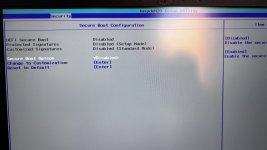LukeBurke947
Member
I have a USB PenDrive with Linux on and am unable to boot into it with my laptop. I have a desktop from PC Specialist which allows me to boot into the os (so I know nothing is wrong with the USB).
Whenever I go into the Boot Options, I can't see an option to boot from USB and after searching online, it seems I have a different BIOS menu to everyone else. Here are the specs for my laptop:
And here is a video of the Insydh20 BIOS menu that I can see:
Is there something I'm missing or do I not have the ability to boot into the OS? I don't want to install it onto my Windows 10 laptop, just boot into it like I can on my desktop computer.
Whenever I go into the Boot Options, I can't see an option to boot from USB and after searching online, it seems I have a different BIOS menu to everyone else. Here are the specs for my laptop:
| Chassis & Display | Proteus Series: 15.6" Matte Full HD 144Hz 72% NTSC LED Widescreen (1920x1080) |
| Processor (CPU) | Intel® Core™ i7 Six Core Processor 9750H (2.6GHz, 4.5GHz Turbo) |
| Memory (RAM) | 32GB Corsair 2666MHz SODIMM DDR4 (2 x 16GB) |
| Graphics Card | NVIDIA® GeForce® GTX 1660 Ti - 6.0GB GDDR6 Video RAM - DirectX® 12.1 |
| 1st M.2 SSD Drive | 1TB INTEL® 660p M.2 NVMe PCIe SSD (upto 1800MB/sR | 1800MB/sW) |
| 1st Storage Drive | 1TB SEAGATE BARRACUDA 120 2.5" SSD, (upto 560MB/sR | 540MB/sW) |
And here is a video of the Insydh20 BIOS menu that I can see:
Is there something I'm missing or do I not have the ability to boot into the OS? I don't want to install it onto my Windows 10 laptop, just boot into it like I can on my desktop computer.

